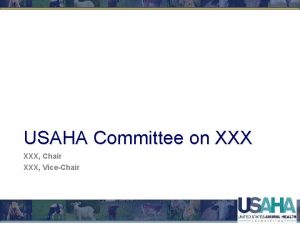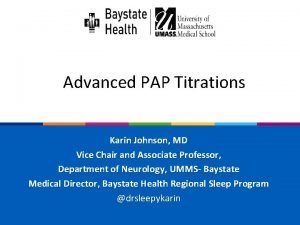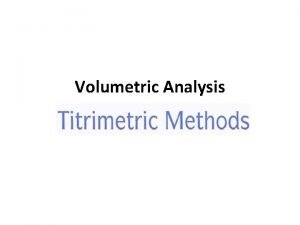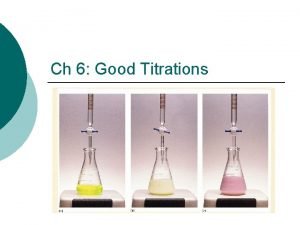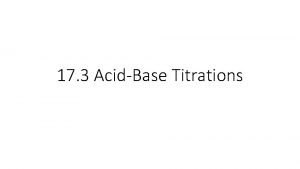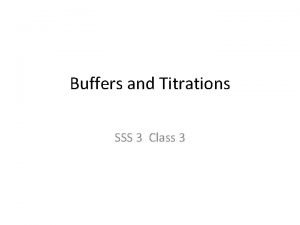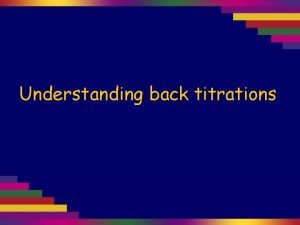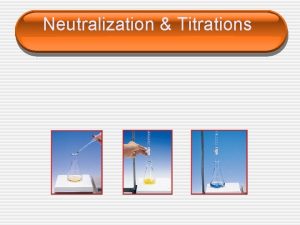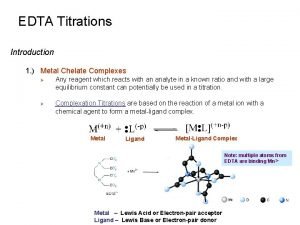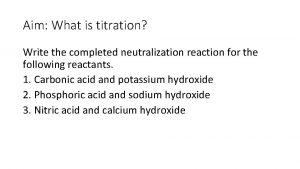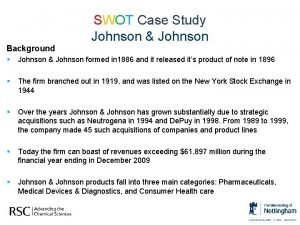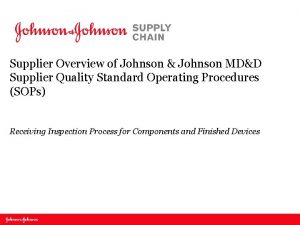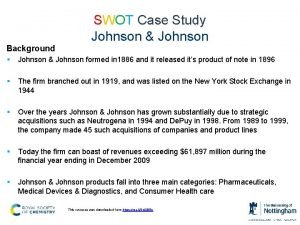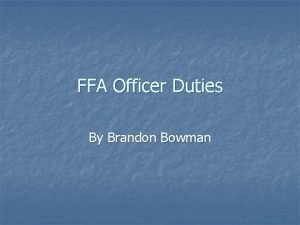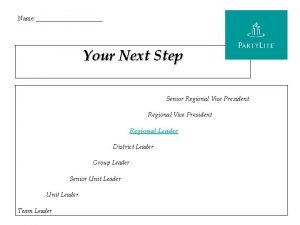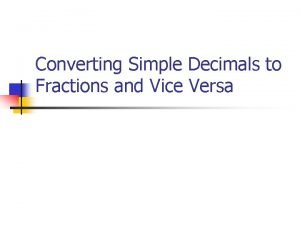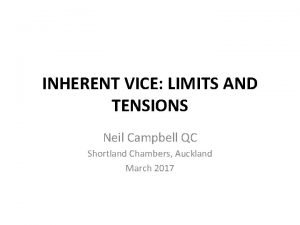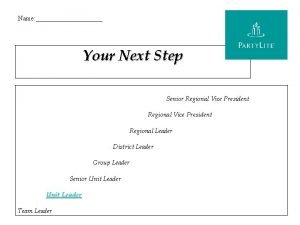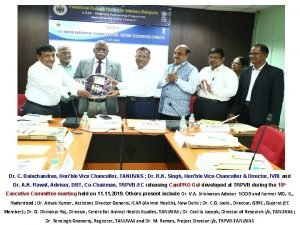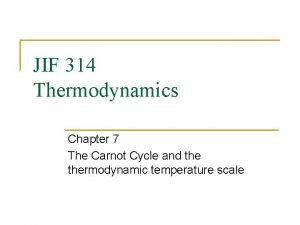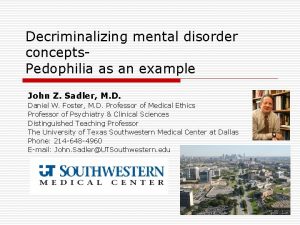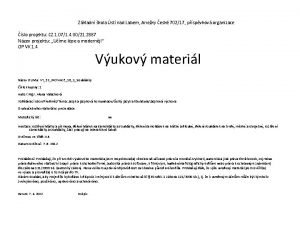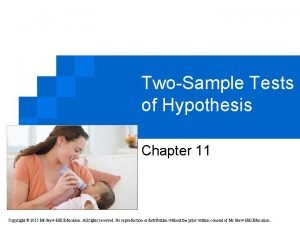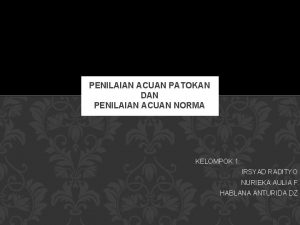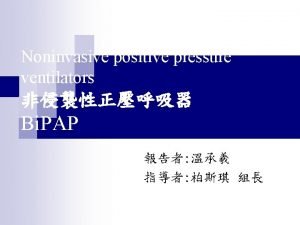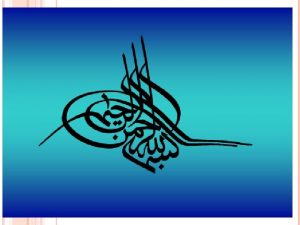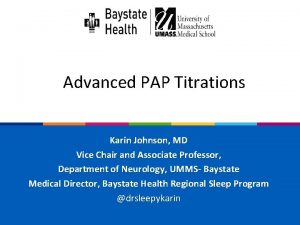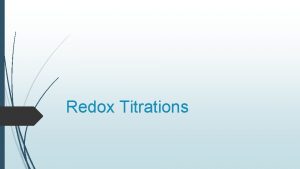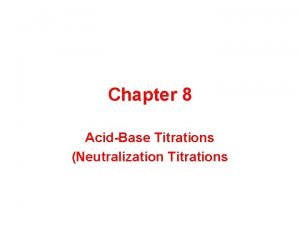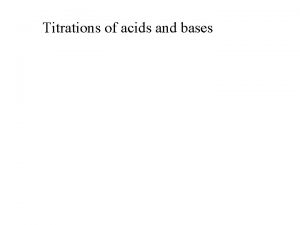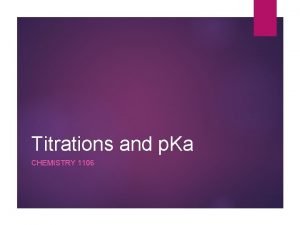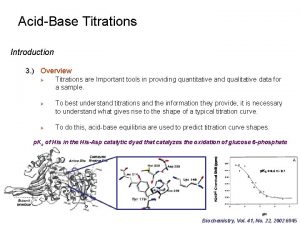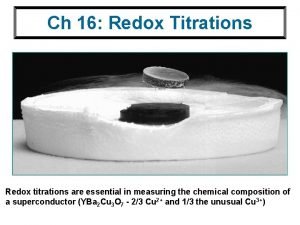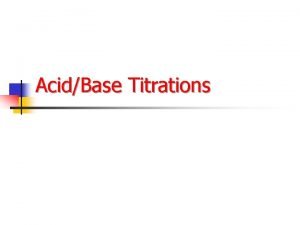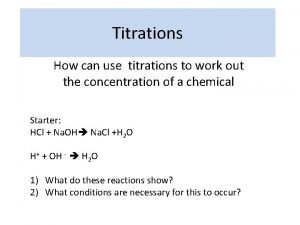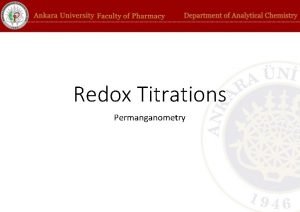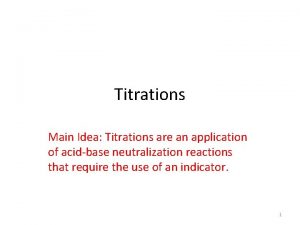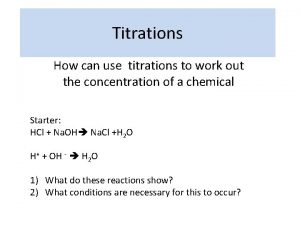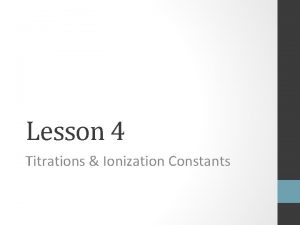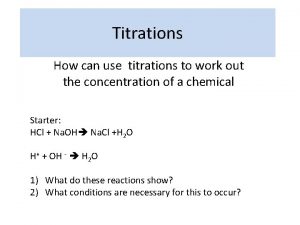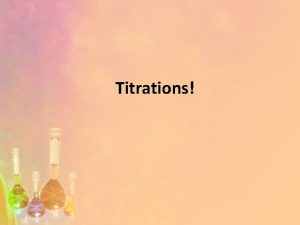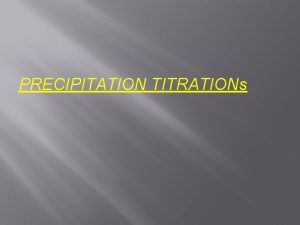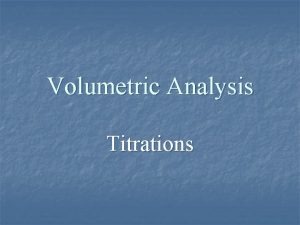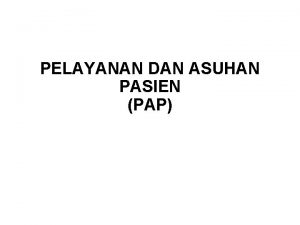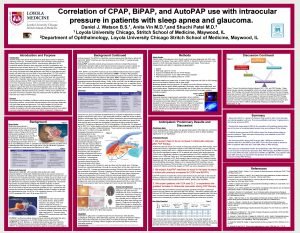Advanced PAP Titrations Karin Johnson MD Vice Chair























































- Slides: 55

Advanced PAP Titrations Karin Johnson, MD Vice Chair and Associate Professor, Department of Neurology, UMMS- Baystate Medical Director, Baystate Health Regional Sleep Program @drsleepykarin

Disclosure • No Disclosures • I will be comparing protocols/functionality of different PAP devices from specific manufacturers http: //www. petpoisonhelpline. com/poison/beta-blockers/

Summary • • How Advanced PAP works Titration Tips Insurance Criteria Titration Case

Advanced PAP Settings Mode BPAP ST SV VAPS Constant EPAP, IPAP, PS all night Backup rate ensures breath within time period Control inspiratory/expiratory lengths Fixed or auto EPAP in response to obstruction Variable IPAP/PS targeting recent volumes or ventilation Backup rate and inspiratory/expiratory control Fixed or auto. EPAP in response to obstruction Variable IPAP/PS targeting set goal volume or ventilation Backup rate and inspiratory/expiratory control

Inspiration Expiration Decision Circuitry • Inline sensor measuring flow or pressure drop across a restriction in the air delivery tube • Start of exhalation: Flow into lungs = 0 • Inhalation- Flow(t) > average flow rate • Exhalation- Flow(t) < average flow rate Sanders, US Patent 5, 433, 193 Flow Zero Small positive Large positive Small positive Zero Small Negative Large Negative Small Negative Zero Rate of change Increasing slowly Steady Decreasing slowly Decreasing fast Decreasing slowly Steady Increasing slowly Steady Fuzzy Phase Start Inspiration Early Inspiration Peak Inspiration Late Inspiration Start Expiration Early Expiration Peak Expiration Late Expiration Expiratory phase Berthon Jones, US Patent 8857430

Respiratory Control Settings • Tigger sensitivity – inspiratory flow above which EPAP -> IPAP • Cycle sensitivity – inspiratory flow below which IPAP -> EPAP • Rise time – length of time to transition from EPAP to IPAP • Inspiratory Time – Time spent in inspiration

Respiratory Control Settings Setting Normal COPD Obesity Hypoventilation Restrictive/ Neuromuscular Ti 0. 3 -1. 0 sec 0. 8 -2. 0 sec 0. 8 -1. 5 sec Rise Time 0. 3 sec-2. 0 sec 300 ms 150 -300 ms Trigger Medium-High Cycle Medium High Low-Medium Low COPD - Chronic obstructive pulmonary disease; sec - second; Ti - inspiration time Adapted from Res. Med Sleep Lab Titration Guide Start with normal settings then add to see if helps comfort or breathing metrics

Differences in BPAP ST • Respironics – Spontaneous breaths are not affected by Ti settings • Resmed – Spontaneous breaths are affected by Ti settings – Can use respiratory control settings on both BPAP and BPAP ST

Physiology affecting COPD Titrations • Auto. PEEP and Dynamic Hyperinflation + Elastic Recoil – Narrowed bronchiole and decreased elastic recoil Airway supported by connective tissue • Slower flow in and out of lung • More collapse on expiration when positive pressure – More compliant alveoli • Inspiratory flow remains higher longer especially when on Bi. PAP • May require active exhalation when on Bi. PAP to cycle • More dead space – Higher minute ventilation to clear CO 2 + NORMAL + Excess mucus, hypertrophy of submucosal glands, abnormal epithelium + Decreased Elastic Recoil = Slower expiratory flow + Broken alveolar attachments = Airway collapse worse on expiration COPD

Titrating COPD patients • Look for improvement in Tidal Volumes first and then reductions in CO 2 Titration change Improved Physiology Mechanism Higher EPAP Auto. PEEP Kept airways more open by offsetting Auto. PEEP High IPAP Airway Collapse Work of Breathing Prevent airway collapse High Cycle And/or Shorter Ti Decreased Elastic Recoil Limit Inspiratory Flow Work of Breathing Prolong Exhalation Auto. PEEP Slower RR Impaired exhalation Prolong Exhalation • Preventing dynamic hyperinflation – If worsening with increasing EPAP or PS then likely inducing hyperinflation

Hi-PPV in COPD Patients with chronic COPD with frequent exacerbations • Severe COPD mean Pa. CO 2 57 • 12 -month risk of readmission or death • 63% in O 2 +Hi-PPV • 80% in O 2 alone • ARR 17% (NNT 6) • 34% reduction in acute exacerbation frequency Bi. PAP ST • Ti 0. 8 -1. 5 RT 150 -200 ms • Started 18/4 RR 14 -16 • Mean IPAP 24 (22 -26) • BPPV targeted to goal ↓Pa. CO 2 3 -7 mm. Hg and Sp. O 2 >88% Murphy JAMA 2017

CO 2 targets by Disease • COPD: to reduce by 3 -7 mm. Hg or 20% or <48 mm. Hg (Murphy 2017) • Obesity Hypoventilation: to get tidal volume over 6 -8 ml/kg (NIPPV task force) • Neuromuscular: aim to keep CO 2 at wake levels

Advanced PAP Settings Mode BPAP ST SV VAPS Constant EPAP, IPAP, PS all night Backup rate ensures breath within time period Control inspiratory/expiratory lengths Fixed or auto EPAP in response to obstruction Variable IPAP/PS targeting recent volumes or ventilation Backup rate and inspiratory/expiratory control Fixed or auto. EPAP in response to obstruction Variable IPAP/PS targeting set goal volume or ventilation Backup rate and inspiratory/expiratory control

Problem with CPAP/BPAP ST • Breathing patterns that change breath to breath • Periodic breathing Not enough pressure to prevent obstruction Too high pressure drops CO 2 levels and increases breathing instability triggering periodic breathing • Breathing patterns/ ventilation that change throughout the night Not enough pressure to ventilate in REM and supine Too high pressures in NREM or lateral position inducing 1. Central events 2. PAP intolerance 3. Mask leak 4. Hyperinflation in COPD

Tip 1: Watch for BPAP ST lengthening Rhythmic Central apneas BPAP ST • Longer central apneas • Flow is backup rate kicking in • More instability/arousals

Tip 2: Watch for Oxygen Banding Pattern • Sign of periodic breathing • Rhythmic desaturations to similar degree • Rarely below 80% • Improves in REM

Tip 3: Score Central Hypopneas • 30% reduction in pressure transducer for 10 seconds with arousal or 3% O 2 desat AND NO • Snoring OR • Flow limitation OR • Paradoxical breathing

Tip 4: Watch for Mixed Events • Decreased drive often causes airway collapse • BPAP may can squaring of flow signal • Think central physiology even if a little snoring and flow limitation if – Worse NREM/Better REM – Symmetric periodic waxing and waning of both flow and effort – Worsening with increasing PAP pressures – Arousals at height of respiratory effort

Tip 5: Recognize Different Types of Central Physiology • Rhythmic – High loop gain, driven by CO 2 fluctuations – Backup rate can worsen • Irregular – Driven by central breathing suppression (narcotics) – Neuromuscular – Backup rate can help

Servoventilation (SV) Pressure Profile • Fixed or auto EPAP in response to obstruction • Variable IPAP/PS targeting recent volumes or ventilation • Backup rate • +/- Inspiratory/expiratory control Goal • Stabilize breath by breath variation Uses/ Cautions • Periodic breathing • Cheyne Stokes Respiration • Treatment induced central sleep apnea • Can worsen hypoventilation

Servoventilation (SV) Res. Med ASV • Targets 90% recent minute ventilation • Adjusts PS every 1/50 th seconds • Auto. ASV adjusts EPAP for OSA Respironics Bi. PAP Auto. SV • Targets 90 -95% recent tidal volume • Mid-inspiration adjustment • EPAP adjustment for sustained periodic breathing or OSA Patient Flow ASV pressure Apnea ASV turned on Hill Patent 2008/ 0000475

Titrating ASV • Typically start EEP 4 -5 unless severe obstruction • Slowly increase EEP for events or instability • Generally keep PS min at 3 and PS max at 15 – If difficulty tolerating pressure decrease PS max to 10 – If can’t eliminate centrals can try PS min of 0 • Make sure NO mask leak • If hypoventilation switch to VAPS • If ASV doesn’t work try Auto. SV and vice versa

Volume Assured Pressure Support (VAPS) Pressure Profile Goal Uses/ Cautions • Fixed or auto. EPAP in response to obstruction • Variable IPAP/PS targeting set goal volume or ventilation • Backup rate • Inspiratory/expiratory control • Stabilize breath by • Combination of breath variation periodic breathing • Ensure stable and ventilation hypoventilation throughout entire • Supine or REM night dominant disease • Hypoventilation • Neuromuscular

i. VAPS vs AVAPS i. VAPS Fixed EPAP AVAPS EPAP System. One AVAPS- fixed EPAP Adjustment Trilogy AVAPS- AE- set EPAPmin and Auto. EPAP (Astral) max with REMstar Auto. CPAP-like protocol PS PS adjustments are made • Determines average PS provided over Adjustment every 1/50 th sec throughout prior 2 min to achieve volume. inspiration to achieve goal • If target volume differs from average alveolar ventilation with recent ventilation (6 breaths), PS for smooth transition. next breath is changed at rate of 1/min if recent stable breathing and 0. 5/min if unstable breathing. • (AE mode allows maximum rate of pressure change from 1 -5/min).

Minute ventilation, alveolar ventilation and tidal volume • Tidal volume (Bi. PAP Auto. SV and AVAPS) – Volume to lung and anatomical dead space – If ↑ respiratory rate, alveolar ventilation ↑ • Minute Ventilation (ASV target) – Respiratory rate X tidal volume – If ↑ respiratory rate, alveolar ventilation ↓ • Alveolar ventilation (i. VAPS target) – Minute ventilation – dead space ventilation – If ↑ respiratory rate, then TV ↓ and alveolar ventilation is constant

AVAPS-AE and i. VAPS backup rate • AVAPS-AE backup rate – Fixed or Autoset which is 2 breaths per min below average rate of recent 6 spontaneous breaths • i. VAPS patient rate – Patient rate drops to 2/3 rd of set rate during spontaneous breathing and increases to set rate during period of apnea From resmed. com

Titrating VAPS • Start with EPAP at pressure preventing very severe obstructive events although lower may work • Start TV/ TVa per body weight chart • Start PS min 4 and PSmax of 15 -20 • Start RR/Patient Rate at respiratory rate • COPD has more dead space ventilation so expect to use higher Tva/TV • Start normal but try adding in ventilatory control settings in appropriate patients- ie, COPD, neuromuscular • Don’t just keep increasing EPAP and Tva/TV • Record tidal volumes and PS min and max achieved by patient throughout titration • Watch for setting increases that lead to lower patient TV for a given setting change

Tip 6: Follow Tidal Volumes and IPAP max values when titrating i. VAPS Note: IPAP Max is maxed out for further increases of TVa at this point not significantly changing TV or lowering CO 2 If increase patient rate, can increase ventilation

Case 1: Hypoventilation/Hypoxia with Treatment emergent centrals on BPAP 16/9 in REM Stable Breathing O 2 Sat: 84% TCCO 2: 56 BPAP 17/9 in NREM Treatment induced centrals O 2 Sat: 92% TCCO 2: 51

Case 1: ASV treats treatment emergent centrals ASV EEP 7: O 2 saturations improved to 93% Breathing most stable in NREM TCCO 2 still 50 ASV EEP 8: O 2 saturations drop in REM to 88 -89% TCCO 2 increases to 53 …. but worsens hypoventilation

Case 1: i. VAPS improves centrals and hypoventilation i. VAPS EPAP 9 TVa 6 PR 20

RAD Criteria for SV/VAPS/BPAP ST • To qualify for an E 0471 Respiratory Assist Device (RAD)- Bi. PAP ST, ASV, i. VAPS, AVAPS 1. Central sleep apnea at baseline with CAHI >5 with OAHI < 5 2. Treatment emergent centrals with CAHI > 5 with OAHI < 5 on Bi. PAP (If get centrals on CPAP, also get them on Bi. PAP before switching to backup rate machine) • This must be present on at least 1 Bi. PAP pressure without higher pressures with either OAHI > 5 or higher pressures with overall AHI <5 3. Hypoventilation Criteria on Bi. PAP- Requires ABG on Bi. PAP

Ventilator Criteria For VAPS • To qualify for ventilator (Astral or Trilogy with i. VAPS/AVAPS or Bi. PAP settings) – Medical documentation of chronic respiratory failure – ABG with PCO 2 > 52 if COPD or obesity hypoventilation or PCO 2>45 or MIP < 60 if Neuromuscular – In this case do not need to meet either central criteria or 5 minutes below 88% on oxygen criteria • Expensive monthly rental fee • Must have persistent chronic respiratory failure to stay on • No compliance requirements to keep the machine

Case 2: OSA/Hypoventilation/Hypoxia • • 69 yo male with DM, HTN, Morbid obesity (BMI 49), CAD s/p triple bipass admitted for CHF exacerbation in 2013 In 2005, dx with severe OSA and hypoventilation and didn’t tolerate CPAP 6 Split Study Baseline on 4 L oxygen – – • AHI 37 Lowest O 2 sat 77% Average ETCO 2 52 Peak ETCO 2 89 Titration – Lowest O 2 sat 70% – Peak ETCO 2 99

Case 2: PSG on 4 liters oxygen What about the CO 2 levels?

Tip 7: Check ETCO 2 waveform • ETCO 2 signal can be affected by • • Apnea: no airflow to the sensor • Hypnopnea: if don’t reach end expiration • Reduced tidal volume: don’t reach end expiration • Obstruction: due to air trapping/lack of equilibration • Mask leak: loss of signal • High PAP flow: diluting signal ETCO 2 correlates poorly with ABG in specific patient populations – – COPD Small lung volumes Obesity Acute respiratory illnesses Noninvasive monitoring of CO 2 during polysomnography: a review of the recent literature Christopher A. Gerdung, Adetayo Adeleye, and Valerie G. Kirk Curr Opin Pulm Med 2016, 22: 527 – 534

Case 2: BPAP 16/6 with 4 L O 2 Why are saturations in 70 s on Bi. PAP with 4 L oxygen, when they were in 90 s with 4 L oxygen?

Tip 8: Be aware of oxygen dilution with PAP • Oxygen flow diluted by room air flow (21% Fi. O 2) from the machine • Higher pressure, more O 2 flow needed for same Fi. O 2 • If the patient is on daytime O 2, make sure they are switching to the appropriate (higher) level with PAP

Case 2: BPAP ST 20/14 RR 14 4 L O 2 REM hypoventilation with BPAP Tip: BPAP can cause squared airflow pattern that can be confused for obstruction Overall: • Treatment emergent centrals • Prolonged centrals with Bi. PAP ST • Persistent Hypoxia • Persistent Hypoventilation

Next day AVAPS titration – Next day comes back for AVAPS titration • AVAPS with EPAP of 14, IPAP min of 18, IPAP max of 30, TV of 550 and 4 liters of oxygen and backup rate of 14 with a heated humidifier.

Case 2: AVAPS EPAP 14 min TV 550 IPAPmin 18 IPAPmax 30 rate 10 O 2 4 L • Persistent central events • Oxygen Banding in NREM

Case 2: AVAPS EPAP 14 min TV 550 IPAPmin 18 IPAPmax 30 rate 10 O 2 4 L • Persistent Hypoventilation worse in REM

Case 2: AVAPS Followup • Uses AVAPS 4 L O 2 nightly • “Fights with it all night” • Sleeps 4 -5 hours on machine with awakenings after about 2 hours then has to take it off • Difficulty falling asleep and staying asleep, daytime fatigue, nocturia

Case 2: i. VAPS EPAP 10 TVa 5. 6 PR 12 with 2 liter O 2

Case 2: Sleep Clinic Follow-up • Recommend i. VAPS – – – • • EPAP of 9 qnd TVa of 5. 6 PS min of 4 and PS max of 20 Patient Rate of 14 Ti min 0. 3, Ti max 2, High Cycle 2 liters oxygen Took over 1 month to get approval to switch to i. VAPS “Great sleep on i. VAPS”, ESS 5 -> 0, sleeping 9: 30 -5 AM Average use 6 h 57 min, 26/30 days over 4 hours, Residual AHI 2. 3

Tip 9: Fixing hypoventilation helps hypoxia • Alveolar Gas Equation • PAO 2 = Fi. O 2(Barometric Pressure – PH 2 O) – PACO 2/Respiratory Quotient 760 47 0. 8 • The more space CO 2 takes up the less space for O 2 in the alveola • PAO 2 = 0. 21 (760 -47) – 40/0. 8 = 99 mm Hg ~ > 95% Sa. O 2 • PAO 2 = 0. 21 (760 -47) – 60/0. 8 = 74 mm. Hg ~ 92% Sa. O 2 • PAO 2 = 0. 21 (760 – 47) – 80/0. 8 = 49 mm. Hg ~ 80% Sa. O 2 Image from Becker Anesthesia Progress 2009

6 titration elements Element Exacerbating Factors Obstruction Worse REM, Supine Hypoventilation Worse REM/ Supine Periodic breathing (PB)/Cheyne Stokes respiration (CSR) Worse NREM/Supine Worse higher pressures Worse hypoxia/hypoventilation Worse backup rate Irregular centrals (narcotic) Narcotic effect could be worse at start of night Insufficient effort (Neuro) Worse REM/Supine Baseline Hypoxia Worse REM/Supine

Titration hierarchy Obstruction • CPAP Hypoventilation Hypoxia • BPAP +/-respiratory control • VAPS • BPAP- w/ hypoventilation • O 2 - w/o hypoventilation Periodic Centrals • SV – w/o hypovent • VAPS- w hypovent

Obesity Hypoventilation Titration Hypoventilation only No OSA • Bi. PAP/Bi. PAP ST/VAPS • Long Ti • Short rise time • May need large pressure support • Many need increased backup rate CPAP Central events or Persistent ↑CO 2 or Persistent ↓O 2 Bi. PAP +/- respiratory control settings Central criteria or ↑CO 2 on max Bi. PAP VAPS Persistent ↓O 2 VAPS + O 2 Suboptimal response to everything including lateral positioning Bi. PAP ST +/- O 2

CHF Titration *Vary to meet insurance qualifications OSA +/- ↓O 2 +/- ↑CO 2 Persistent ↓O 2 CPAP + O 2 Central criteria w/ Nl CO 2 Baseline CSA only Normal O 2 +/- ↑CO 2 Mixed CSA + OSA +/- ↓O 2 +/- ↑CO 2 Hypoventilation +/- ↓O 2 Persistent CSA CPAP Central criteria w/ nl CO 2 but primarily CSA at baseline in patients with EF < 30% SV if normal CO 2 and not primarily CSA at Persistent baseline in Centrals patients with EF < 30% Baseline CSA only With ↓O 2 Normal CO 2 Persistent ↑CO 2 +/- central criteria Central criteria VAPS + O 2 Oxygen Bi. PAP Persistent ↓O 2 Bi. PAP + O 2 Persistent Centrals with nl CO 2 Persistent ↓O 2 Hypoxia normal CO 2 CPAP or SV with end expiratory rebreathing space +/- O 2 Suboptimal response to everything else including lateral positioning Bi. PAP ST +/- O 2

COPD Titration *Vary to meet insurance qualifications OSA +/- hypoxia and +/- hypoventilation Persistent ↓O 2 CPAP Persistent ↑CO 2 +/- central criteria CPAP + O 2 Central criteria Normal CO 2 SV Hypoxia without hypoventilation Hypoventilation +/- Hypoxia Persistent centrals Oxygen Bi. PAP Persistent ↓O 2 w/ normal CO 2 Central criteria or ↑CO 2 on max Bi. PAP VAPS Persistent ↓O 2 VAPS + O 2 Bi. PAP + O 2 Central criteria • Bi. PAP/Bi. PAP ST/VAPS • short Ti • high cycle • short rise time • Watch for EPAP or pressure support that start making CO 2 rise more or lower TV as sign of worsening hyperinflation • Increase patient rate if hypoventilation despite recorded IPAP during titration at PSmax Suboptimal response to everything else including lateral positioning Bi. PAP ST + O 2

Final Titration Tips • Beware of snore artifact and BPAP “squaring” leading to overtitration and missing central physiology • O 2 may be able to be reduced once treat hypoventilation • VAPS and SV often need lower EPAP than BPAP • If one SV or VAPS device doesn’t work, try another • Higher pressures are not always better, but some evidence that COPD may require high PS

Insurance Qualification Summary • Score central hypopneas to qualify for BPAP with backup (BPAP ST, SV, VAPS) • If VAPS best for controlling hypoventilation, but doesn’t qualify, consider if meets ventilator criteria • Almost impossible to switch from one Backup rate machine to other

Final Titration Tips • Tech’s goal should be to show setting options in different stages and positions • MD may need to extrapolate optimal setting and follow adherence data residual AHI, oximetry and ABG to adjust after set-up • Think about the underlying physiology interacts with PAP • You may not be able to fix everything • Some patients can never be fixed in supine position

Good luck titrating • Karin. johnson@baystatehealth. org • @drsleepykarin • For more information regarding how PAP modes work – Johnson & Johnson Treatment of sleep disordered breathing with positive airway pressure devices: technology update. Medical Devices: Evidence and Research 2015: 8: 425 -437.
 Xxx vice-chair
Xxx vice-chair Karin johnson
Karin johnson Complexometric titration definition
Complexometric titration definition Precipitation titration curve
Precipitation titration curve Good titrations
Good titrations Types of titrations
Types of titrations Buffers and titrations
Buffers and titrations Back titrations
Back titrations Neutralization titrations
Neutralization titrations Example of auxiliary complexing agent
Example of auxiliary complexing agent Formulas for titration
Formulas for titration Laurie johnson brad johnson
Laurie johnson brad johnson Jjeds johnson
Jjeds johnson Johnson and johnson organizational structure
Johnson and johnson organizational structure Johnson and johnson values
Johnson and johnson values Dreikurs classroom management theory
Dreikurs classroom management theory Johnson and johnson swot analysis
Johnson and johnson swot analysis Understanding the mirai botnet
Understanding the mirai botnet Johnson and johnson md&d
Johnson and johnson md&d Johnson and johnson bcg matrix
Johnson and johnson bcg matrix Swot johnson and johnson
Swot johnson and johnson Vyklad
Vyklad Ffa vice president duties
Ffa vice president duties Senior regional vice president
Senior regional vice president Vice president training
Vice president training Changing decimals to fractions and vice versa
Changing decimals to fractions and vice versa Vice president training
Vice president training Vice president membership
Vice president membership What do vice presidents do in clubs
What do vice presidents do in clubs Microsoft executive briefing center
Microsoft executive briefing center Neil campbell qc
Neil campbell qc Ducks unlimited checks
Ducks unlimited checks Senior regional vice president
Senior regional vice president Party is such sweet sorrow vice game
Party is such sweet sorrow vice game Vice reinos espanhois
Vice reinos espanhois Tanuvas vice chancellor
Tanuvas vice chancellor Conversion of work into heat and vice versa
Conversion of work into heat and vice versa Simon city royals symbols
Simon city royals symbols Senior regional vice president
Senior regional vice president Vice-laden
Vice-laden Senior regional vice president
Senior regional vice president Ano ang obras pia's
Ano ang obras pia's Inherent vice of capitalism
Inherent vice of capitalism Where is the ffa vice president stationed
Where is the ffa vice president stationed Age of vice president
Age of vice president Extremism in pursuit of liberty is no vice
Extremism in pursuit of liberty is no vice Lee tait
Lee tait Více hlásek než písmen
Více hlásek než písmen Mary jo fitzpatrick is the vice president
Mary jo fitzpatrick is the vice president Vice president of club duties
Vice president of club duties Hola pap
Hola pap Coloración pap mart
Coloración pap mart Penilaian acuan kriteria
Penilaian acuan kriteria Bipap呼吸器
Bipap呼吸器 Cara menghitung taksiran berat janin
Cara menghitung taksiran berat janin Pa catheter normal values
Pa catheter normal values
